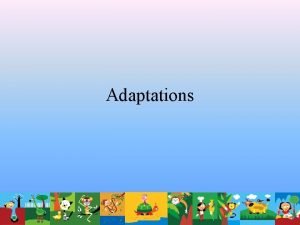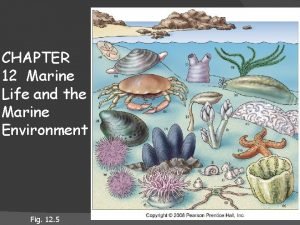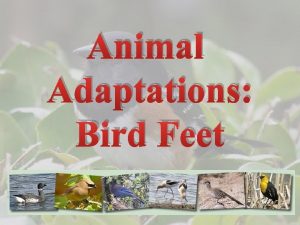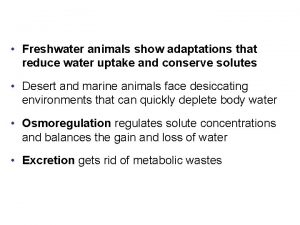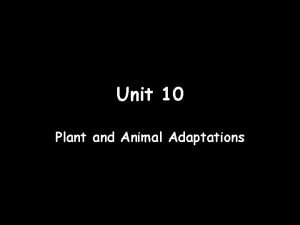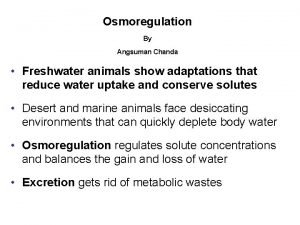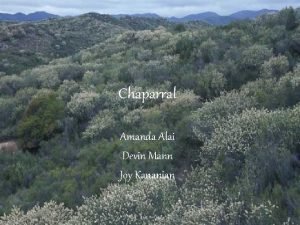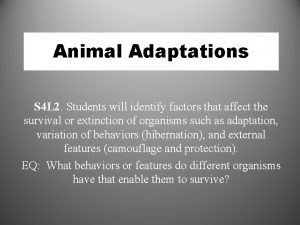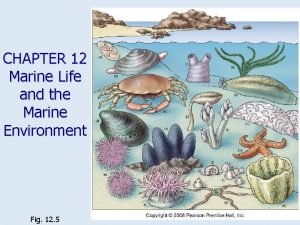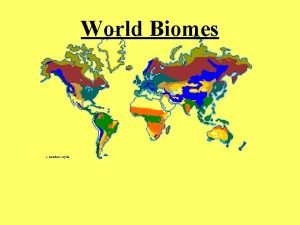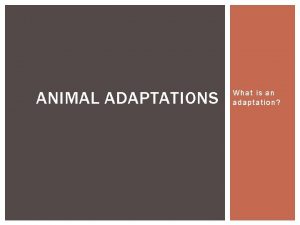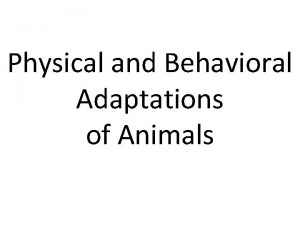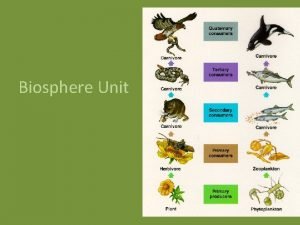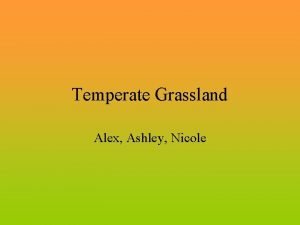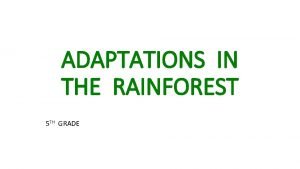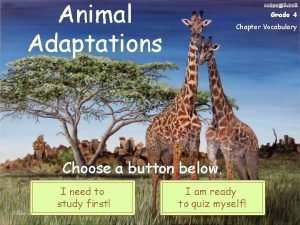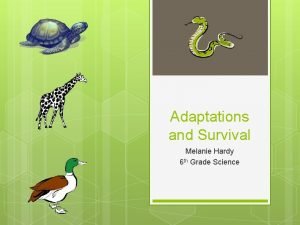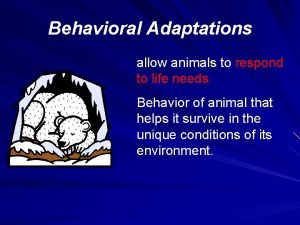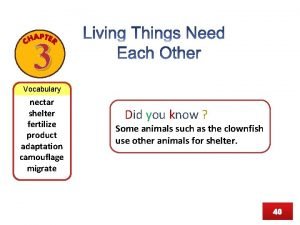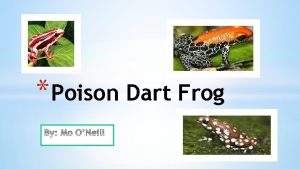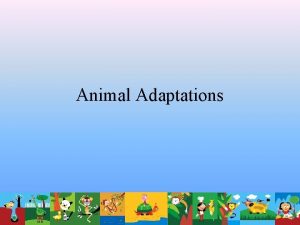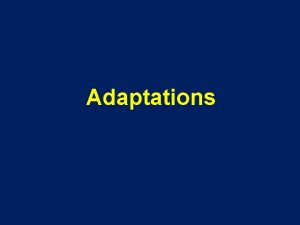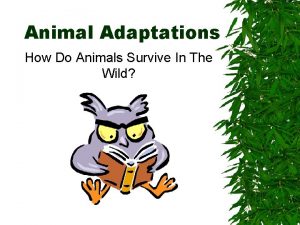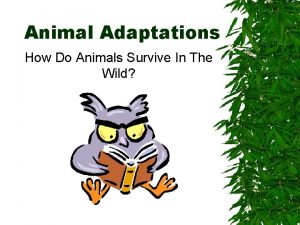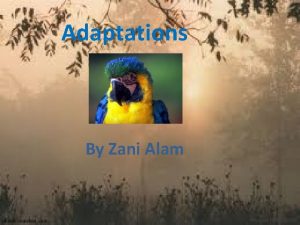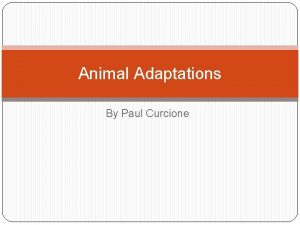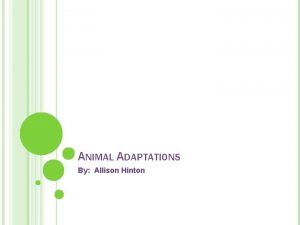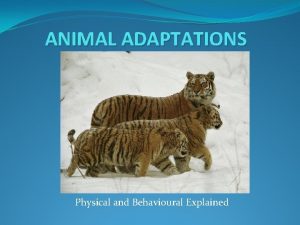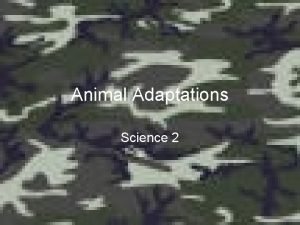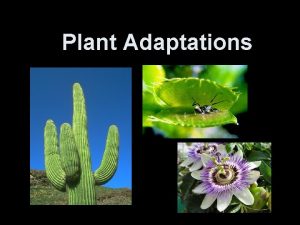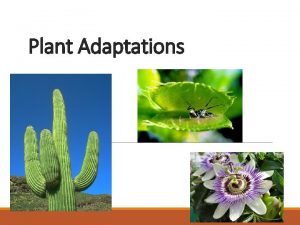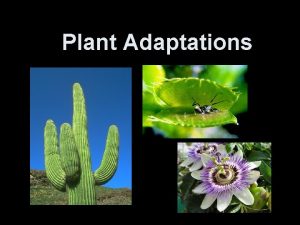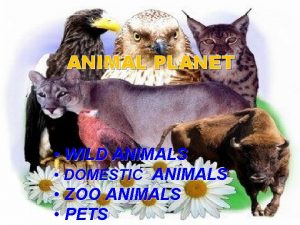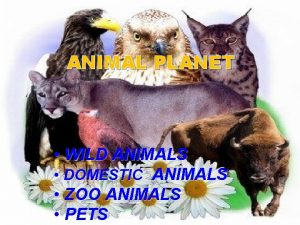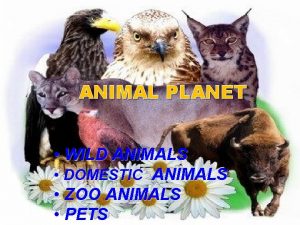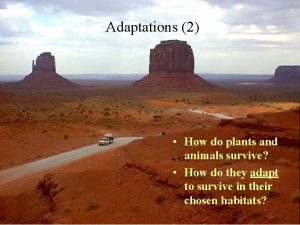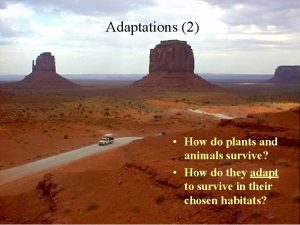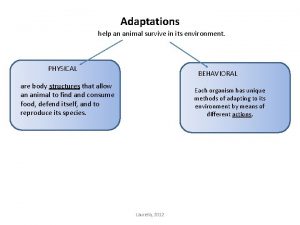Animal Adaptations How Do Animals Survive In The































- Slides: 31

Animal Adaptations How Do Animals Survive In The Wild?

1. 2. 3. Find food to grow Defend against predators Find mates for reproduction

Ø Ø Ø Body parts—structural adaptation Behavioral adaptation Physiological adaptation Learned behavior Coloration/Camouflage

Structural Adaptation

Structural Adaptation A body part that aids in survival Examples: Ø Fins Ø Gills Ø Teeth Ø Streamline body Ø No eye lids

How do different feet types aid in survival?

Structural Adaptation A body part that aids in survival Examples: Heron’s feet are for wading in mud Eagle’s feet for grabbing and holding prey Duck’s feet are for swimming Sparrow’s feet are for perching

Ø Ø Ø Body parts—structural adaptation Behavioral adaptation Physiological adaptation Learned behavior Coloration/Camouflage

Behavioral Adaptation

Behavioral Adaptation An action that aids in survival Clown fish seek shelter from predators in sea anemones. Sea anemones are poisonous to other marine creatures.

Behavioral Adaptation

Behavioral Adaptation An action that aids in survival Lions stay together in a pride. As a group they can help each other hunt, care for young, and watch for danger.

Ø Ø Ø Body parts—structural adaptation Behavioral adaptation Physiological adaptation Learned behavior Coloration/Camouflage

Physiological Adaptation

Physiological Adaptation Jobs of the body parts controlling life process that aid in survival. A bear’s body slows down in the winter. This helps them survive the long winter temperature and scarce food during winter months. Many know this as hibernation. Most bears do not sleep through the entire winter. They do get up and change dens, so this is not true hibernation, but a winter sleep.

Physiological Adaptation

Physiological Adaptation Jobs of the body parts controlling life process that aid in survival. Dolphins are mammals and need to breath air. They spend their entire lives in the water and their body’s have adapted so that they can hold their breath for several minutes.

Ø Ø Ø Body parts—structural adaptation Behavioral adaptation Physiological adaptation Learned behavior Coloration/Camouflage

I have learned to adapt to my new home.

I have learned to live in your backyard.

Learned Behavior Humans have destroyed many animal habitats. Many animals have learned to adapt to their new surroundings. They have found shelter, food, and learned how to stay away from moving vehicles (well most of the time).

Ø Ø Ø Body parts—structural adaptation Behavioral adaptation Physiological adaptation Learned behavior Coloration/Camouflage



Camouflage Protective Coloration Camouflage in which colors and patterns of organisms match the surrounds. This helps animals hide from predators.

Camouflage Protective Resemblance

Camouflage Protective Resemblance

Camouflage Protective Resemblance Camouflage in which shapes and colors of organisms match other objects in the surroundings. The milk snake (top) resembles the poisonous coral snake(bottom). The vice roy butterfly (top) resembles the sour-tasting monarch (bottom).


Protective Coloration Many animals only line of defense is their colors. The warning colors of red, yellow, orange, and bright blue warn others that these animals might be dangerous and should be avoided! These dart frogs are poisonous.

 How do adaptations help animals?
How do adaptations help animals? Marine animals with unique adaptations
Marine animals with unique adaptations Plant adaptation in temperate forest
Plant adaptation in temperate forest Feet adaptations in animals
Feet adaptations in animals Freshwater animals and adaptations
Freshwater animals and adaptations Tufted saxifrage adaptations
Tufted saxifrage adaptations Camel adaptations
Camel adaptations Freshwater animal adaptations
Freshwater animal adaptations Chaparral animals adaptations
Chaparral animals adaptations Temperate seasonal forest plant adaptations
Temperate seasonal forest plant adaptations Aardwolf adaptations
Aardwolf adaptations Temperate forest animals adaptations
Temperate forest animals adaptations How do adaptations help animals? *
How do adaptations help animals? * Marine adaptation
Marine adaptation Bougainvillea tropical rainforest
Bougainvillea tropical rainforest What are adaptions
What are adaptions Is hibernation a physical adaptation
Is hibernation a physical adaptation Https://a-z-animals.com
Https://a-z-animals.com Are bears producers or consumers
Are bears producers or consumers Animals that eat both plants and animals
Animals that eat both plants and animals Animals that eat both plants and animals
Animals that eat both plants and animals Webquest new york
Webquest new york Animal adaptations in the amazon rainforest
Animal adaptations in the amazon rainforest Grassland
Grassland Animal adaptations for rainforest
Animal adaptations for rainforest Where does the common bottlenose dolphin live
Where does the common bottlenose dolphin live Animal adaptations grade 4
Animal adaptations grade 4 Abiotic factors in taiga
Abiotic factors in taiga Studyjams animal adaptations
Studyjams animal adaptations Chipmunk behavioral adaptations
Chipmunk behavioral adaptations Animal adaptations
Animal adaptations Golden poison dart frog adaptations
Golden poison dart frog adaptations
